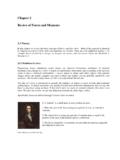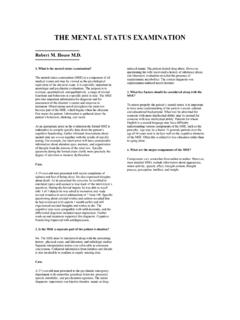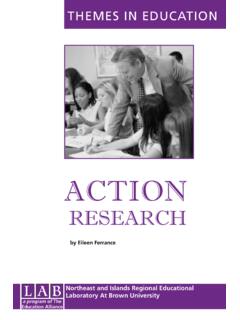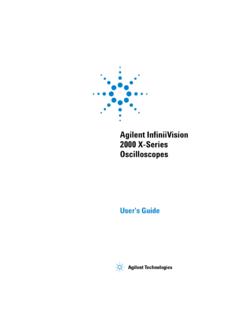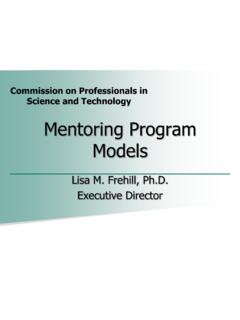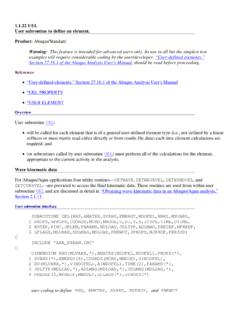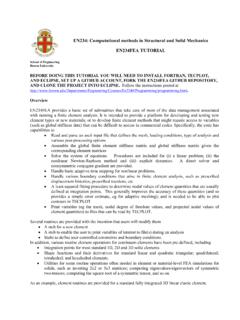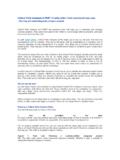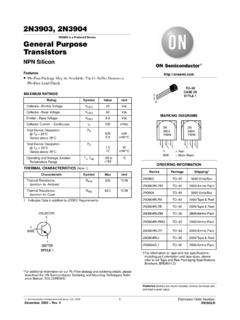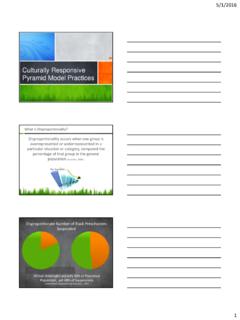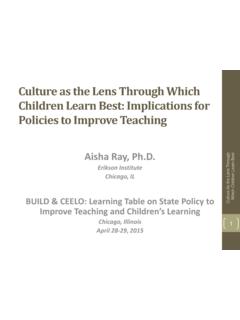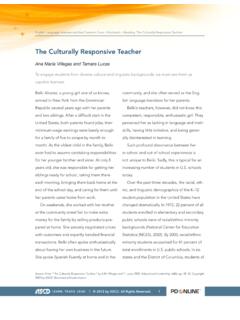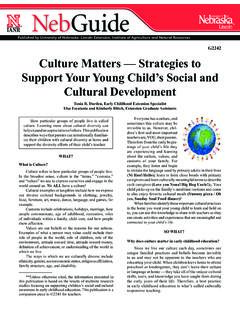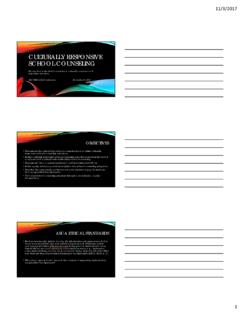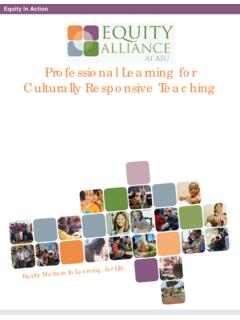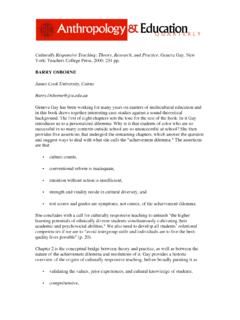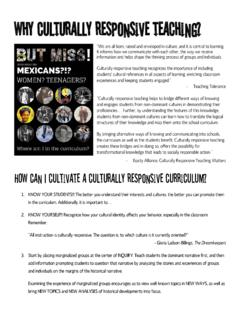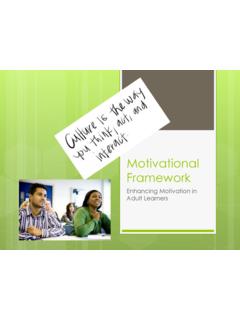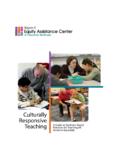Transcription of Culturally Responsive Teaching - Brown University
1 Culturally Responsive Teaching Excerpts from The Knowledge Loom: Educators Sharing and Learning Together Web site ( ). Date of download: 11/03/2008. Spotlight URL: Publisher: The Education Alliance. Brown University ( ). 1999 2008 Brown University Table of Contents The Knowledge Loom: Educators Sharing and Learning What is The Knowledge Loom?..i Are there other resources on The Knowledge Loom?..i What spotlight topics are currently available?..i Overview of Spotlight: Culturally Responsive Communication of High Expectations There are consistent messages, from both the teacher and the whole school, that students will succeed, based upon genuine respect for students and belief in student Teacher as Facilitator Within an active Teaching environment, the teacher's role is one of guide, mediator, and knowledgeable consultant, as well as Cultural Sensitivity To maximize learning opportunities, teachers gain knowledge of the cultures represented in their classrooms and translate this knowledge into instructional Culturally Mediated Instruction Instruction is characterized by the use of Culturally mediated cognition, Culturally appropriate social situations for learning, and Culturally valued knowledge in curriculum Reshaping the Curriculum A reshaped curriculum is Culturally Responsive to the background of Student Controlled Classroom Discourse Students are given the opportunity to control some portion of the lesson.
2 Providing teachers with insight into the ways that speech and negotiation are used in the home and Small Group Instruction and Academically Related Discourse Instruction is organized around low pressure, student controlled learning groups that can assist in the development of academic Active Teaching Methods Instruction is designed to promote student engagement by requiring that students play an active role in crafting curriculum and developing learning Positive Perspectives on Parents and Families of Culturally and Linguistically Diverse Students There is an ongoing participation in dialogue with students, parents, and community members on issues important to them, along with the inclusion of these individuals and issues in classroom curriculum and Mr. Diaz's Fourth Grade Class, Alfred Lima Sr. Elementary Mary Fran Honeyman's second grade Catherine Carney's ESOL Class, Dedham High School, Dedham, Ms. Patalano's 1st Grade Related Web Content i ii The Knowledge Loom: Educators Sharing and Learning Together The attached document is a user generated download of selected content found on The Knowledge Loom Web site.
3 Content on The Knowledge Loom is always being updated and changed. Check online for the most current information. What is The Knowledge Loom? The Knowledge Loom is an online professional development resource featuring specially organized spotlights on high priority education issues, including: a list of promising practices (including an explanation of each practice and a summary of the research or theories that support the practice). stories about the practices in action in actual education settings lists of related resources found on other web sites. The site is designed to help educators facilitate decision making, planning, and benchmarking for improved Teaching and learning through collaborative activities. Are there other resources on The Knowledge Loom? In addition to printable content, the site features interactive tools that allow users to share information and knowledge, read what panels of practitioners have to say about selected topics, ask questions of content experts, and print custom documents like this one.
4 A companion guidebook, Using The Knowledge Loom: Ideas and Tools for Collaborative Professional Development ( ), can be downloaded. It offers activities and graphic organizers to support collaborative inquiry about what works in Teaching and learning in support of school improvement. What spotlight topics are currently available? Adolescent Literacy in the Content Areas Culturally Responsive Teaching Elementary Literacy Good Models of Teaching with Technology Leadership Principles in Technology Middle School Mathematics Principal as Instructional Leader Redesigning High Schools to Personalize Learning School, Family, and Community Partnerships Successful Professional Development Teaching for Artistic Behavior: Choice Based Art i download: 11/03/2008. 2 Spotlight Overview Overview of Spotlight: Culturally Responsive Teaching This overview provides an outline of all content components of this spotlight that are published on The Knowledge Loom Web site. The creator of this document may have printed only selected content from this spotlight.
5 View complete content online ( ). What is Culturally Responsive Teaching ? The notion of Culturally Responsive education is premised on the idea that culture is central to student learning. According to Gloria Ladson Billings, "It is an approach that empowers students intellectually, socially, emotionally, and politically by using cultural referents to impart knowledge, skills and attitudes." The use of cultural referents in Teaching bridges and explains the mainstream culture, while valuing and recognizing the students' own cultures. This link between culture and classroom instruction is derived from evidence that cultural practices shape thinking processes, which serve as tools for learning within and outside of school (Hollins, l996). Thus, Culturally Responsive education recognizes, respects, and uses students' identities and backgrounds as meaningful sources (Nieto, 2000) for creating optimal learning environments. This topic documents case studies of Culturally Responsive practice.
6 It makes explicit the work of teachers who use and respect their students' languages, cultures, and life experiences through the following principles: Practices Each practice includes an explanation, a summary of each story that exemplifies the practice, a research summary (review of the literature), a reference list of the literature, and a short list of related Web resources (URLs and full annotations provided online or in the Related Web Resources section if it has been printed). Communication of High Expectations There are consistent messages, from both the teacher and the whole school, that students will succeed, based upon genuine respect for students and belief in student capability. Active Teaching Methods Instruction is designed to promote student engagement by requiring that students play an active role in crafting curriculum and developing learning activities. Teacher as Facilitator Within an active Teaching environment, the teacher's role is one of guide, mediator, and knowledgeable consultant, as well as instructor.
7 Positive Perspectives on Parents and Families of Culturally and Linguistically Diverse Students There is an ongoing participation in dialogue with students, parents, and community members on issues important to them, along with the inclusion of these individuals and issues in classroom curriculum and activities. Cultural Sensitivity To maximize learning opportunities, teachers gain knowledge of the cultures represented in their classrooms and translate this knowledge into instructional practice. Reshaping the Curriculum A reshaped curriculum is Culturally Responsive to the background of students. Culturally Mediated Instruction Instruction is characterized by the use of Culturally mediated cognition, Culturally appropriate social situations for learning, and Culturally valued Spotlight Overview 3. download: 11/03/2008. knowledge in curriculum content. Student Controlled Classroom Discourse Students are given the opportunity to control some portion of the lesson, providing teachers with insight into the ways that speech and negotiation are used in the home and community.
8 Small Group Instruction and Academically Related Discourse Instruction is organized around low pressure, student controlled learning groups that can assist in the development of academic language. Stories The Stories correspond to the summaries printed as part of each practice published on The Knowledge Loom. These are detailed examples of how the practices look in action in educational settings. Catherine Carney's ESOL Class, Dedham High School, Dedham, MA. Mary Fran Honeyman's second grade classroom Mr. Diaz's Fourth Grade Class, Alfred Lima Sr. Elementary School Ms. Patalano's 1st Grade Class Related Web Resources: 25. This is an annotated list of resources found on other Web sites that relate to the spotlight topic on The Knowledge Loom. The Education Alliance at Brown University 4 Spotlight Overview Practices This section presents the Knowledge Loom practices for the spotlight you selected. Each practice includes an explanation, a summary of each story that exemplifies the practice, a research summary (review of the literature), a reference list of the literature, and a short list of related Web resources (URLs and full annotations provided online or in the Related Web Resources section of this document).
9 For an overview of additional content presented on The Knowledge Loom Web site that may not have been selected for this print document, see the Overview of Spotlight located earlier in the document. Practices 5. download: 11/03/2008. Communication of High Expectations There are consistent messages, from both the teacher and the whole school, that students will succeed, based upon genuine respect for students and belief in student capability. High expectations influence teacher student relations and affect student performance, motivation, and self concept. Positive measures on the part of teachers and schools reflect the attitudinal prerequisites for effective Teaching in a multicultural society. Examples of positive measures for teachers are: calling on students frequently, giving ample feedback, and praising. schools are: de tracking, offering challenging curriculum, and providing intensive time on task. Teachers understand student behavior in light of the norms of the communities in which they are raised and respect all students as learners with knowledge and experience.
10 Questions to Think About Do teachers or schools send subtle messages to students that convey low expectations? How can schools test themselves to make sure they are communicating high expectations? How do we create an environment of academic discourse? Story Summaries Mr. Diaz's Fourth Grade Class, Alfred Lima Sr. Elementary School Teacher conveys belief that learning is a serious endeavor, with many rewards and demands. Students are required to show their work and explain their processes to others. Students frame relevant questions and help determine appropriate tasks and sequence. Students are trained to make their own choices and express themselves in an environment of academic discourse. The principles of Culturally Responsive Teaching abound in Mr. Diaz's Teaching practice in his 4th grade class at Alfred Lima, Sr., Elementary School. Perhaps the best example of his practice is the efficacy with which he communicates high expectations to each student. This message is personalized for individual students at every opportunity.
